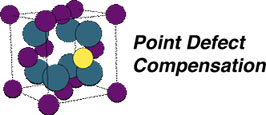|
|
|
Questions to Answer
The following questions are posed as the outline for a report. Clear statements providing answers to these question make up your lab report.
Introduction
1) What was the objective of your work?
2) What method(s) did you employ?
3) Which hypothetical defect structures did you consider?
4) What range of compositions did you study?
5) What limited the possible range of compositions?
[Note: the purpose of an introduction is to state the subject and the objective of the work. The introduction may also describe the experimental strategies, the reason that this course of action was chosen, and the range of parameters that were explored. ]
Procedure
1) How did you grind and prepare the powder for the density measurement?
2) What instruments were used?
3) What did the powdered samples look like (colors)?
4) For how long were the samples purged with He for the density measurements?
[Note: the procedure describes the details of your method, with sufficient accuracy to be duplicated. Of special interest are novel or original procedures that were developed for your work and elements of the procedure that were identified as critical to the success or failure of the project.]
Results
1) You should make a table that contains the following information for each specimen: composition, cubic lattice parameter, mass, volume, and density. You should also make a graph of composition v. density that includes the hypothetical models.
2) How many trials did you carry out?
3) Estimate the errors in your measurements and their effect on the measured density.
[Note: the results section should specify, in detail (numerically when possible) the results of your work. In addition, it is usually appropriate to qualify the results through comparisons. All figures (images and graphs) must be clearly labeled. In the text, refer to each figure by the number (for example, Fig. 1)]
Discussion
1) Which defect model is most consistent with the experimental results?
2) Were all of the samples phase pure?
3) The phase diagram for this system indicates that the cubic d-phase is stabilized by Nb additions. Is this consistent with the defect model?
4) If this material is to be used as an ionic conductor, what is the ideal composition?
[Note: in the discussion section you should explain and interpret the results, develop conclusions, and suggest modifications. In the event of unsatisfactory results, this is the place to propose explanations. In addition, it is often appropriate to place the results of your work in context by comparing your results with established knowledge. ]
Conclusions
Which defect model provides the best explanations for your observations?
[Note: in this section you make a brief statement of the central conclusions of your work]
|
|



